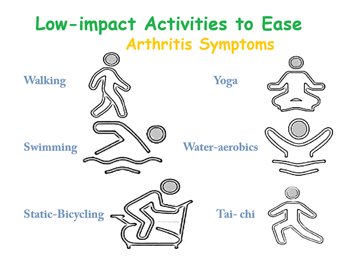Can Physical Activity Help Improve My Arthritis?
Arthritis is a condition that causes inflammation, pain, and stiffness in the joints.
Living with arthritis can sometimes make movement challenging, but staying active is one of the best ways to protect joint health and improve mobility. Regular physical activity helps strengthen the muscles around your joints, improve flexibility, and reduce stiffness.
However, high-impact activities—such as running, jumping, or intense aerobics—can increase joint stress, potentially wearing down cartilage more quickly. This extra stress may worsen pain, inflammation, and stiffness over time.

What low-impact activities can help ease arthritis symptoms?
Low-impact exercises— such as walking- are especially beneficial because they place minimal stress on the joints.Here are some good examples of low-impact exercises that are gentle on the joints and helpful for people with arthritis:
✅ Walking – Easy, adaptable, and can be done almost anywhere.
✅ Swimming – Buoyancy of water reduces joint stress while improving strength and flexibility.
✅ Water aerobics – Adds resistance training in a joint-friendly environment.
✅ Cycling or stationary biking – Strengthens leg muscles with minimal joint impact.
✅ Rowing – Improves cardiovascular health and upper-body strength without pounding the joints.
✅ Yoga – Enhances flexibility, balance, and muscle tone while being gentle.
✅ Tai chi – Slow, flowing movements that improve balance and reduce stiffness.
Engaging in such gentle activities can also help manage body weight, which is crucial for reducing strain on weight-bearing joints like the knees and hips.
Practical tips to protect your cartilage and joints during activities, especially if you have arthritis or want to prevent joint wear and tear:
- Warm Up Before Exercise – Light stretching or gentle movements increase blood flow and prepare your joints for activity.
Maintain a Healthy Weight – Every extra kilogram of body weight puts additional stress on weight-bearing joints, especially the knees and hips.
Strengthen Supporting Muscles – Strong muscles around the joints (especially the quads, hamstrings, and core) absorb shock and reduce strain on cartilage.
Wear Supportive Footwear – Well-cushioned shoes absorb impact and keep your joints aligned during movement.
Avoid Overtraining – Give your joints time to rest and recover between intense or repetitive activities.
Use Proper Form & Technique – Poor posture or incorrect movement patterns can place uneven pressure on cartilage.
Stay Hydrated – Cartilage is made largely of water; staying hydrated helps maintain its cushioning properties.
Incorporate Flexibility Training – Stretching and mobility work keep joints moving freely and reduce stiffness.
Keynote
In the long run, consistent low-impact activity can slow the progression of arthritis, improve overall strength, and enhance quality of life.Consulting a healthcare provider or physical therapist can help you create a safe, personalized exercise plan that fits your needs. Remember, movement is medicine—so keep your joints happy by choosing exercises that are kind to them. - Medical Disclaimer.
Read further on:
≺≺ What not to eat when you have Gout?
≺≺ How common is thumb pain from too much texting?
≺≺ What are the four enemies of blood sugar?
≺≺ What type of exercise is best for lowering my blood sugar?
≺≺ What impact can sitting for long periods have on my health?
≺≺ Does my social circle impact my weight?
≺≺ How toxic are the nitrites used in curing processed meats?
≺≺ How can I reduce the risk of cancer-causing chemicals when cooking or grilling meat?
≺≺ What foods can lower prostate cancer risk?
≺≺ What can I do to supercharge my green tea?
≺≺ Why should I combine Avocados and Tomatoes?
≻≻ Watch this page for more such informative articles on Health, Nutrition, and Wellness.
≻≻-Back to Home page.
Further reading (External Links opens in new window):
≺≺- CDC- About Physical Activity and Arthritis.
≺≺- Harvard Health Publishing - 4 ways exercise helps arthritis.